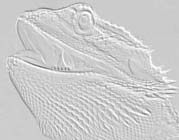 |
 |
|||
 |
||||
|
Mouth rot is a systemic infection that often shows up as a whitish, or yellow-gray cheesy substance in the soft tissues of the mouth. In advanced cases, the head may be quite swollen, and teeth may be loose. You need to take your dragon to a vet for a proper diagnosis and antibiotic treatment if you suspect he has mouth rot. Treatment usually consists of treating the mouth with diluted solutions of Betadine and Nolvasan. The plaques that form along the teeth and gums must be dislodged - preferrably by a vet. It is important that the plaques not be injested by the Beardie. After the debris is cleaned out of the mouth, antibiotic treatment can begin. During the course of the antibiotic therapy, the mouth should be checked daily to watch for any regrowth of plaques. It is not unusual for this process to be repeated two or more times during recovery. Particularly severe cases may require more than a single treatment. If there
is any bleeding upon the removal of the first plaque, the Beardie may
be started on a 10 day course of antibiotics. Beardies can carry a variety of negative bacteria. The bacteria may not be the underlying cause of the stomatitis, their existence may slow the recovery. The presence of negative bacteria may require that two antibiotics be administered simultaneously. Most veterinarians use a broad-spectrum antibiotic, but these may not be effective. The standard culture sampling techniques of swabbing or washes may a yield a confusing mixture of natural and opportunistic buccal and environmental flora. A better method for obtaining a sample for culturing in resistant stomatitis cases is to make an incision into the infected gum and take a small sample of the infected tissue. Reptiles suffering from stomatitis often cease or greatly reduce voluntary intake of food and water. Supportive therapy should include replacement of fluids and administration of vitamin B-complex and vitamin C . Vitamin A may also be supplemented with care given to administer only very small doses due to potential toxicity. If the patient is going to be tube-fed, vitamin A should be given orally, mixed in with the food. If the Beardie has not eaten in some time, solid food should not be given. Force feeding whole prey is stressful under the best of conditions, additional stress should be minimized as much as possible. Instead, offer a nutritional slurry orally. Baby food makes a great base for a slurry. Add in calcium and vitamins as needed. Beardies
should be kept near the upper end of their required temperature gradient
to ensure maximum benefit from the antibiotics and to boost their immune
system function. Reptiles who would otherwise have temperatures dropped
at night should be kept near their normal daytime temps. (Remember,
never use bright light to heat an enclosure at night time.) Water should
be supplied either by dripping droplets onto the Beardie's nose to lap
up or by misting or bathing.
|
||||
| This information should be used only as a reference tool and should not be used in place of vet assistance. My views and opinions are the result of hours of dedicated research. But remember, I am not a professional. If you have a sick beardie and don't know what to do, don't play God, take him to the vet immediately. | ||||
|
Copyright
© Beautiful Dragons. All Rights Reserved.
This website may not be copied or reproduced without my permission. |
||||